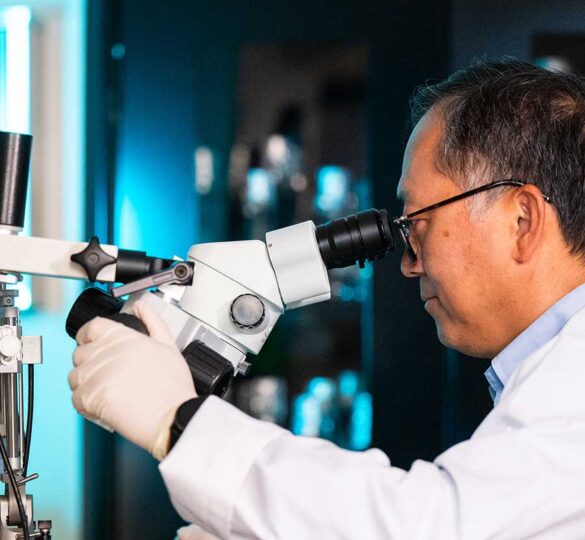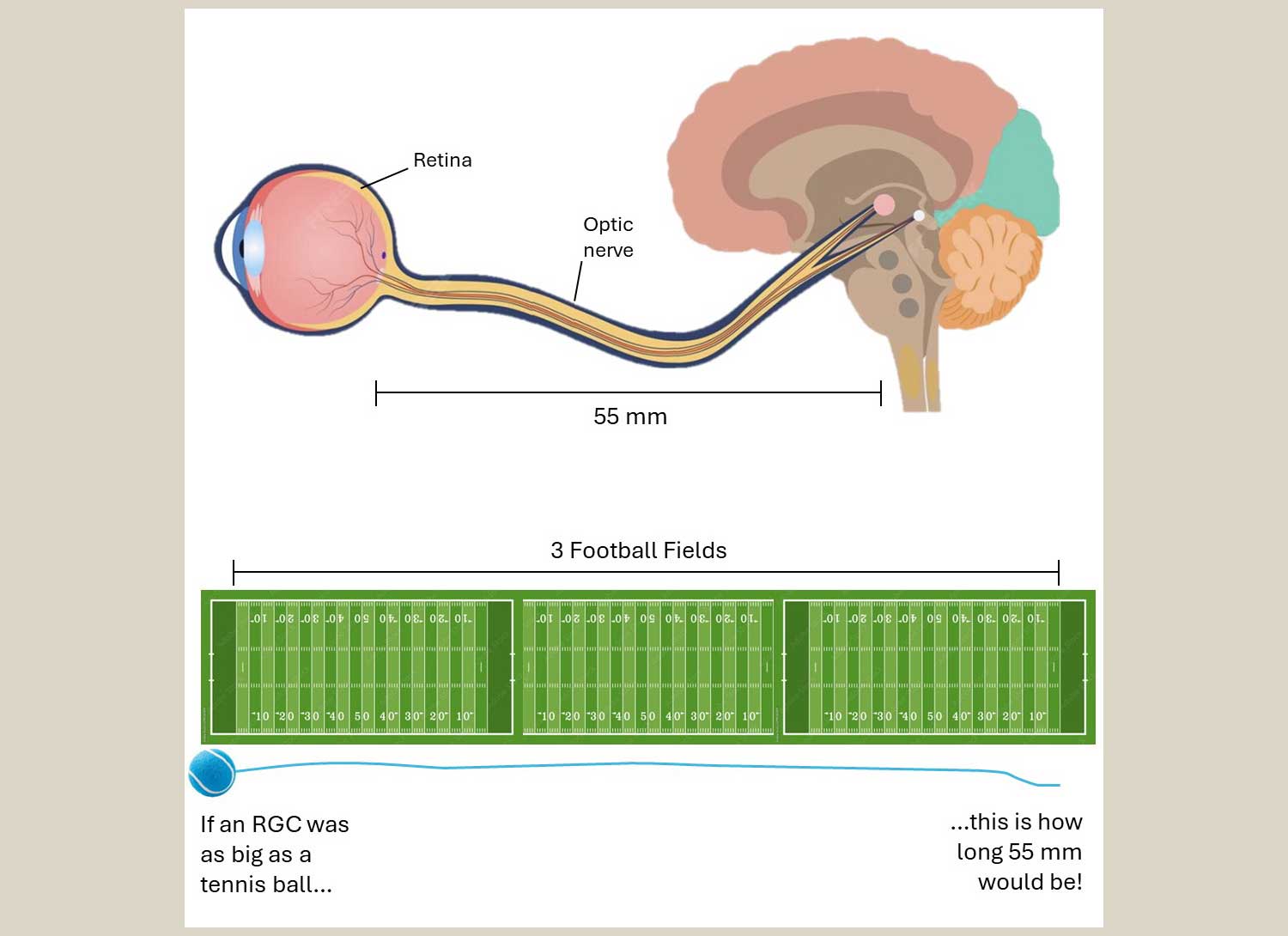The Powerhouse of Vision: How Mitochondria are Linked to Glaucoma
Researchers are looking for new types of treatments that do more than just lower eye pressure.

Mitochondria, often called the “powerhouses of the cell,” are vital for producing the energy that powers our body’s basic building blocks. Tissues with high energy demands, such as our muscles, are packed with mitochondria.
But you probably didn’t know that retinal ganglion cells (RGCs), which send visual information from our eyes to our brains, also have a huge need for energy! There are many reasons for this, but one primary factor is the relatively huge distance that the tiny RGC must send its signal to reach the brain (See Figure 1 below). This makes these crucial neurons highly dependent on healthy mitochondria.
A Critical Energy Crisis in Glaucoma
When mitochondria stop working correctly, RGCs don’t get enough energy to do their usual functions. Scientists studying glaucoma have discovered that this is exactly what happens to RGCs in the early stages of the disease.1 Research shows that problems with mitochondria contribute to stress and even death of RGCs in several ways:
- Changes in Shape: Even before RGCs die, their mitochondria start to look different. They become broken up, swollen, and their inner structures are a mess. All these changes are signs that they aren’t working as they should.2
- Less Energy: RGCs need a lot of energy, especially in the part of the axon inside the eye. In early glaucoma, the mitochondria become less efficient at making energy. This lack of power makes it hard for the cells to do their jobs and protect themselves from stress.1
- Oxidative Stress: When mitochondria are struggling, they create harmful molecules called free radicals (also known as “reactive oxygen species” or ROS). An over-abundance of these free radicals can damage the mitochondria’s own DNA, creating a vicious cycle of more dysfunction and making RGCs more likely to die.3
- Poor Transportation: RGC axons are very long, and mitochondria need to be constantly moved along them to provide energy where it’s needed. One of the earliest things to fail in glaucoma is this “transport system.” It causes a “traffic jam” of old, broken mitochondria near the eye, while the far ends of the axons are starved of energy.4
A 2021 study suggested that problems with mitochondria and inflammation might create a loop that makes glaucoma worse.5 Similarly, a 2023 article pointed out that changes in mitochondria are among the first problems to show up in glaucoma, happening even before nerve cells are lost.6

New Treatments Targeting Mitochondria
Now that we understand how problems with mitochondria play a key role in glaucoma, researchers are looking for treatments that do more than just lower eye pressure. They are hoping to find ways to protect RGCs by improving the health of their mitochondria.
Nicotinamide (Vitamin B3)
Nicotinamide, a form of vitamin B3, is a very exciting area of research. It’s used to create a crucial molecule that mitochondria need to produce energy, called NAD+ (nicotinamide adenine dinucleotide). Studies show that NAD+ levels decline in glaucoma, leading to mitochondrial problems and making RGCs more vulnerable.7
In a major 2017 study, researchers gave high doses of nicotinamide to mice with a type of glaucoma. It dramatically protected their RGCs, in some cases preventing glaucoma from developing in up to 93% of the eyes! This protective effect was not related to eye pressure and was believed to be because the mitochondria were healthier. 7
Later, a 2020 study found that glaucoma patients who took a high dose of nicotinamide for 12 weeks showed significant improvements in their vision.8 Another trial in 2022 also found that a combination of nicotinamide and pyruvate improved vision in patients with glaucoma.9
But be careful! While these findings are promising, organizations like the American Glaucoma Society (AGS) and the American Academy of Ophthalmology (AAO) are urging caution. The high doses used in these trials are much higher than the daily recommended amount. In a few rare cases, some people in a clinical trial had liver problems. Because of this, medical experts recommend against using high-dose nicotinamide unless you are in a clinical trial and have a doctor closely watching your liver function.
Experimental Treatments in Development
Another promising approach is gene therapy, which has been studied for other eye diseases and may also be a new way to treat mitochondrial problems in glaucoma by altering genes that aren’t functioning correctly directly in the cells that need it. One opportunity here is a protein called NMNAT2. NMNAT2 is essential for maintaining levels of NAD+ (the molecule needed for mitochondria to produce energy) and keeping the long RGC axons healthy. Research shows that the activity of NMNAT2 is much lower in the eyes of people with glaucoma, even in the early stages. This drop might be the key event that leads to the “energy crisis” in RGCs.
Dr. Yang Hu, an ophthalmology professor at Stanford University, and his team are working on a gene therapy that would restore levels of NMNAT2 directly in RGCs.10 By using gene therapy to restore NMNAT2 levels, researchers hope to improve mitochondrial health and protect RGCs from the stress of glaucoma. Preclinical studies have shown that this approach can provide significant protection.10 This exciting work from Dr. Hu’s lab is the first potential glaucoma treatment to receive funding from the Glaucoma Research Foundation’s new Treatment Accelerator Initiative.
Final Thoughts
Protecting nerve cells from damage is the ultimate goal of glaucoma treatment. By understanding how problems with mitochondria can lead to the death of RGCs in the early stages, we have a much better chance of finding a cure and preventing blindness. However, it’s important to remember that the treatments discussed here are based on recent research and are not yet widely available. Any changes to your current treatment plan must be discussed with your doctor first.
References
- Kong, G. Y., Van Bergen, N. J., Trounce, I. A., & Crowston, J. G. (2009). Mitochondrial dysfunction and glaucoma. Journal of glaucoma, 18(2), 93-100.
- Tribble, J. R., Vasalauskaite, A., Redmond, T., Young, R. D., Hassan, S., Fautsch, M. P., … & Morgan, J. E. (2019). Midget retinal ganglion cell dendritic and mitochondrial degeneration is an early feature of human glaucoma. Brain communications, 1(1), fcz035.
- Chrysostomou, V., Rezania, F., Trounce, I. A., & Crowston, J. G. (2013). Oxidative stress and mitochondrial dysfunction in glaucoma. Current opinion in pharmacology, 13(1), 12-15.
- Fahy, E. T., Chrysostomou, V., & Crowston, J. G. (2016). Mini-review: impaired axonal transport and glaucoma. Current eye research, 41(3), 273-283.
- Jassim, A. H., Inman, D. M., & Mitchell, C. H. (2021). Crosstalk between dysfunctional mitochondria and inflammation in glaucomatous neurodegeneration. Frontiers in pharmacology, 12, 699623.
- Kuang, G., Halimitabrizi, M., Edziah, A. A., Salowe, R., & O’Brien, J. M. (2023). The potential for mitochondrial therapeutics in the treatment of primary open-angle glaucoma: a review. Frontiers in Physiology, 14, 1184060.
- Williams, P. A., Harder, J. M., Foxworth, N. E., Cochran, K. E., Philip, V. M., Porciatti, V., … & John, S. W. (2017). Vitamin B3 modulates mitochondrial vulnerability and prevents glaucoma in aged mice. Science, 355(6326), 756-760.
- Hui, F., Tang, J., Williams, P. A., McGuinness, M. B., Hadoux, X., Casson, R. J., … & Crowston, J. G. (2020). Improvement in inner retinal function in glaucoma with nicotinamide (vitamin B3) supplementation: A crossover randomized clinical trial. Clinical & experimental ophthalmology, 48(7), 903-914.
- De Moraes, C. G., John, S. W., Williams, P. A., Blumberg, D. M., Cioffi, G. A., & Liebmann, J. M. (2022). Nicotinamide and pyruvate for neuroenhancement in open-angle glaucoma: a phase 2 randomized clinical trial. JAMA ophthalmology, 140(1), 11-18.
- Fang, F., Zhuang, P., Feng, X., Liu, P., Liu, D., Huang, H., … & Hu, Y. (2022). NMNAT2 is downregulated in glaucomatous RGCs, and RGC-specific gene therapy rescues neurodegeneration and visual function. Molecular Therapy, 30(4), 1421-1431.
Article by Cynthia Steel, PhD, MBA. Posted on October 23, 2025. Photo: Yang Hu, MD, Catalyst for a Cure scientist at Stanford University, working to discover neuroprotective cures for glaucoma.

Cynthia Steel, PhD
Cynthia Steel, PhD is the Chief Scientific Officer for Glaucoma Research Foundation. With more than a decade of experience dedicated to the science and strategy behind ophthalmic therapies, her work is grounded in a commitment to improving patient outcomes and translating cutting-edge science into meaningful clinical applications.